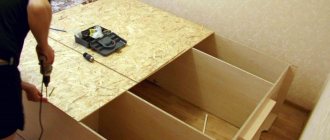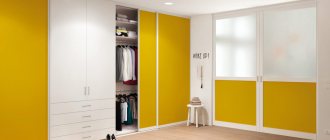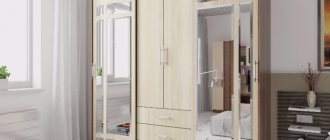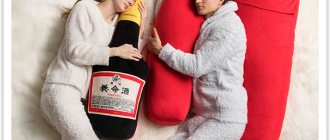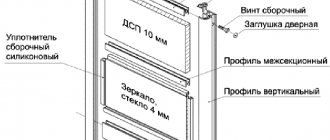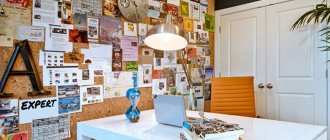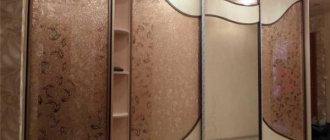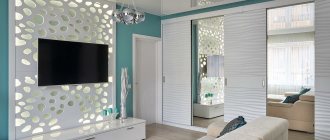Inconspicuous, hidden behind what will be placed on shelves and in niches for hangers, the back wall of the cabinet plays an important role. Many people believe that its main function is to protect everything stored from dust, which will accumulate in the cracks when the body of the three-door or two-door cabinet itself is not tightly connected to the wall. This is why they insist on installing back walls on built-in wardrobes and walk-in closets.
What is the back wall of the cabinet made of?
The back wall of the cabinet is made of fibreboard (fibreboard), laminated chipboard (chipboard).
One sheet may not be enough to cover the entire back surface.
Some people suggest nailing the back of the cabinets.
The fiber panel consists of wood fibers, synthetic resins, fillers and water.
Is different:
- for general and special purposes;
- by hardness: superhard, hard, semi-hard, soft;
- by thickness.
Under load, the wardrobe may become deformed.
The use of a stapler is also not recommended.
Sheets can be smooth on one or both sides, painted, covered with laminated film, or artificial veneer. They also differ in the degree of reaction to moisture, fire resistance, and exposure to sunlight. The most commonly used hard types are fine fraction (MDF) or chipboard and the harder, modern HDF material made from coniferous wood.
To overcome the problems, you can construct the compartment from sections, each of which would require one sheet.
It is best to use self-tapping screws with a washer.
Chipboard is a mixture of sawdust and resins, which under the influence of high temperatures and pressures turns into a homogeneous and durable material.
Repairing the back of the toilet is not an idle question.
If chipboard is used, then holes are first drilled to prevent the board from splitting, and then self-tapping screws are screwed in.
laminated chipboard
Back panels for cabinets made of laminated chipboard are more reliable than fiberboard. They are more durable, mounted to size and have a decorative coating, so they have a more aesthetic appearance. This coating can imitate wood texture or be smooth.
Chipboard is a regular polished chipboard with a lamination section attached. Covering the material with laminating film can be done using three technologies: lamination, lamination, smooth lamination.
To produce this material, a hot press is used, the temperature of which is 160-220 degrees. Several layers of prepared paper and a mixture of different resins are applied to the chipboard, which, when heated, turn into a durable film and reliably protect the surface of the material.
Laminated particle board is available in various thicknesses. There are three options: 10, 16 and 18 mm.
Advantages
- High strength and durability.
- Wide range of colors, allowing you to choose a shade that matches the color of the case.
- Can be installed in confined spaces.
- Possibility of fastening in different ways: euroscrews, angles, eccentrics.
- it is very resistant to moisture and scratches.
Flaws
The only drawback may be the high cost of this material.
The price for installing laminated chipboard walls often reaches the cost of finishing the walls of the room.
Plywood
Plywood is one of the best but expensive materials for the back of furniture. It has a smooth surface that does not require additional grinding. The production process uses heat treatment and drying. Thus, the product retains its presentable appearance for a long time, does not dry out or become deformed.
Plywood is made from different types of wood, but the most popular raw material is birch.
Advantages
It has a uniform and durable structure, so it is used to make smooth, high-quality veneer. After giving the required thickness, the veneer sheets are glued together to form the well-known plywood. Sheets of this material for the back walls of cabinets are traditionally made with a thickness of 3 mm.
Furniture corner
This type of fastening is used to connect two parts. This is a rather fragile connection method, so it is used for fastening parts that should not be subject to heavy loads. Usually these are decorative elements, for example, the base of a cabinet or mezzanine shelves.
Figure 21. The furniture corner is used for fastening decorative furniture elements (plinths) and installing shelves. Made of plastic. Has a cover to hide the clasps. Self-tapping screws 16 mm long are used as fasteners.
Instead of metal corners, plastic ones are often used. They are no less durable, but have a more attractive appearance and the possibility of hidden fasteners. The corner of the cabinet is attached to two mating parts with two self-tapping screws. The lid is then suspended, thereby hiding the fasteners.
Figure 22. The corner of the cabinet is used for fastening lightly loaded furniture elements, as well as for installing decorative elements such as plinths, inserts, etc.
The furniture fasteners discussed in the article are the most common and frequently used, as they are the most versatile and easy-to-use types of fasteners. In the vast majority of cases, the types of furniture fastenings described are sufficient for assembling any furniture.
How to make a wall with your own hands
The back wall of the cabinet is a simple part that does not require special care, so it can be done with your own hands. The main thing is to choose the right raw materials and decide on the method of fastening.
Next, you need to prepare several fragments from the selected sheet of material (you may end up with one). It all depends on how many furniture modules are needed to prepare the back side.
On a note! Cutting plywood, chipboard, fiberboard and other materials must be done strictly with a jigsaw. The fact is that when sawing with a hacksaw or a hand tool, uneven breaks occur and curved edges are formed. And this is not only not aesthetically pleasing, but also dangerous from the point of view of the further functioning of the structure.
There is an unpleasant smell from the back of the cabinet, what should I do?
In this situation, you can try 2 options:
- Treat the entire frame with Smelloff universal odor neutralizer. This product is safe for people and pets.
- If the first option does not help, you should replace the back panel with a new one.
How to remove nails from the back wall?
- If the nail head is exposed, you can pull it out using side cutters or a small nailer.
- If it is deep in the wall, first remove the plug with a wooden punch and then remove the nail with pliers. This method damages the material and will have to be replaced in the future.
- When the back of the fiberboard is overlapped, the best way to remove the nails is to carefully drive a flathead screwdriver between the fiberboard and the cabinet body, gently prying the wall away. The nail heads will be visible and you can remove them using the first method.
How to strengthen the back wall?
To strengthen the structure, it is enough to attach two narrow boards crossed to the back, which will cross the entire surface of the cabinet.
How to strengthen the back wall of a cabinet?
Repairing the back of the toilet is not an idle question. Some people suggest nailing the back of the cabinets.
The advantage of individual models is that they can be disassembled, moved and placed anywhere.
Yes, this method allows you to do it quickly, but fastening the back walls of the cabinets in this way reduces the rigidity of the structure and its strength. In this case, the material of the body and the wall is destroyed, and in the future difficulties arise when disassembling such a product. The use of a stapler is also not recommended. It is best to use self-tapping screws with a washer.
The back wall of the cabinet, the material of which is laminated chipboard, is better in all respects, but also costs five times more.
If chipboard is used, then holes are first drilled to prevent the board from splitting, and then self-tapping screws are screwed in. Increases the rigidity of the entire structure and fixes sheets in selected grooves using a cutter in the end posts, cover and bottom of the product. In this case, it is important that the dimensions of the sheet being fixed match very accurately the dimensions of the room being closed.
Chipboard is a mixture of sawdust and resins.
Fastening is carried out around the perimeter:
- partitions and end walls;
- ceiling on top;
- at the base of the structure;
- to spacious fixed shelves.
They also differ in the degree of reaction to moisture, fire resistance, and exposure to sunlight.
Accessories for rotating shelves
Rotating shelf accessories include:
- upper and lower fixation of the rotation axis;
- the axis of rotation, which is a telescopic metal tube, that is, the height of the pole can be changed according to the dimensions of the cabinet;
- flange mounting bracket.
Installation of a rotating shelf
To install the rotating shelf correctly, you must:
- choose a place to attach the rotation axis so that the installed shelf can move freely inside the cabinet;
- secure the upper and lower connecting structures (simply screwed to the lower and upper parts of the cabinet, respectively);
- install the pin by inserting the pipe into the fixed flanges;
- screw the shelf support to the board;
- install the shelf itself.
The rotating shelf is installed correctly
Therefore, when choosing accessories for shelves, you should proceed from the material from which they are made and the method of fastening the product. In stores you can find many different options for overhead, mortise supports, sliding and rotating mechanisms, the independent installation of which does not cause any difficulties.
MDF, chipboard and fiberboard - what are the differences and what is better
MDF is a fine fraction of wood from which furniture boards are produced by hot pressing. The material is relatively new and environmentally friendly. Unlike chipboard, it does not use formaldehyde or other adhesive components. Often these raw materials are purchased abroad, where safety standards are very strict. On the positive side, one can also mention the relative ease of processing the material, which allows products to have a more complex shape. The downside is the relatively high cost.
Chipboard is a chipboard made, like MDF, from wood waste and solid wood of relatively cheap species. This material has been known for a long time, since Soviet times, and remains loved by consumers for its durability and low cost. If properly treated, chipboard furniture will last for many years and will not fade or warp.
Fibreboard is a fibreboard produced from finely divided wood powder using the so-called “wet” method. The raw materials are impregnated and rolled out, then dried. The thickness of fiberboard is small, so in furniture this material is used only for the back walls of cabinets and the bottom of drawers.
Types of fastenings for different shelves
There are three main types of shelves used in modern furniture:
- Wood. Material - chipboard or MDF. The most common type.
- Cup. They are made of tempered glass using special thermochemical treatment. As a result, additional strength is provided, which allows them to be used in furniture production.
- Net or wire. They have the shape of a metal frame in the form of boxes or baskets.
Today, shelves are made from almost any material, including glass.
There are other modifications to the shelves, such as folding, sliding or height-adjustable. However, no specially designed fittings (except hidden ones) are used for their installation.
Shelves can have various modifications, including with retractable mechanisms.
Decor the back wall of cabinets and shelves with wallpaper
If you initially think that the back of the furniture will be glued “on theme” only in the same places as the walls of the room, then nothing like that! Don't limit yourself to such a banal solution.
The back wall of the cabinet can be decorated with any wallpaper of a similar color. If it is not in stock, look at the shelves for sale in stores and hypermarkets. You need fewer rolls and you don't have to spend much. Geometric patterns look especially impressive and win-win when pasting back walls.
In a classic living room interior, you can choose wallpaper with luxurious Provence or Baroque motifs for covering the open back walls of furniture. This will add atmosphere and a touch of luxury to the overall style of the room.
Fun wallpaper will make the room more cute and cheerful. Especially if the room is on the shady side.
The use of bright and cheerful patterns is appropriate not only in cozy kitchens, but also in bedrooms and children's rooms, wherever you want to enliven the interior and add a good mood to yourself and your loved ones.
Sources
- https://AmiPlus.ru/zona-otdyha/zadnyaya-stenka-mebeli.html
- https://m-strana.ru/articles/zadnyaya-stenka-shkafa-material/
- https://made-box.ru/details/kreplenie-zadnej-stenki-shkafa.html
- https://NuclearFactor.ru/zapahi/zadnyaya-stenka-shkafa-iz-chego-2.html
- https://lkard-lk.ru/dom/iz-chego-sdelana-zadnyaya-stenka-shkafa-vidy-materialov-ih-plyusy-i-minusy
- https://dom-naveka.ru/dom-stroj/chem-obshit-zadnyuyu-stenku-shkafa.html
- https://mebeltorgspb.ru/shkafy/iz-kakogo-materiala-sdelana-zadnyaya-stenka-shkafa.html
- https://12-stuliev.ru/shkafy/zadnyaya-stenka-shkafa.html
- https://VegaMebell.ru/dizajn/krepezh-dlya-zadnej-stenki-shkafa.html
- https://dom.sibmama.ru/drevesn-plity.htm
